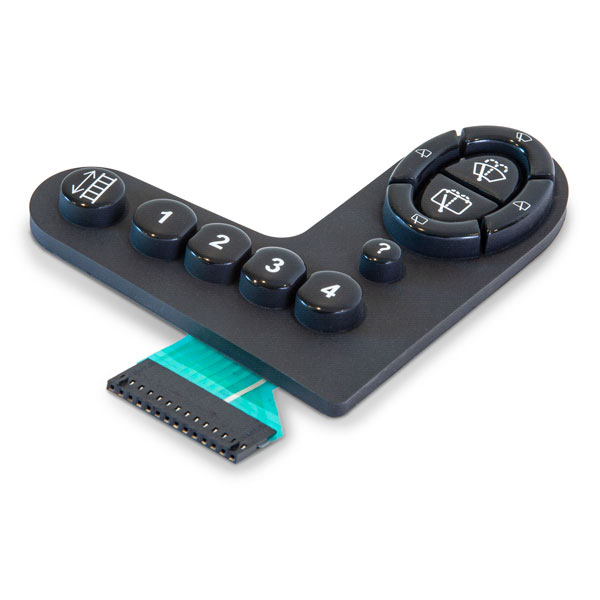Membrane Switch: A Comprehensive Guide to Its Uses and Applications
Membrane Switch: A Comprehensive Guide to Its Uses and Applications
Blog Article
The Advantages of Utilizing Membrane Switches Over in Consumer Electronics
Membrane layer buttons are increasingly acknowledged for their substantial advantages in customer electronics, particularly in boosting customer interaction and improving production processes. The adaptability in layout allows for customized solutions that fulfill diverse customer requirements.
Improved Individual Experience

In today's affordable landscape of customer electronics, boosted individual experience is extremely important; almost 85% of users focus on user-friendly user interfaces. Membrane layer switches play an essential duty in attaining this level of use.
The responsive comments provided by membrane buttons is vital for guiding customer activities, making certain that commands are registered properly. This comments device decreases mistakes and heightens customer fulfillment, fostering a favorable partnership between the tool and the user. In addition, the personalized nature of membrane changes permits producers to tailor user interfaces to particular customer needs, making tools a lot more accessible and inviting.
Additionally, membrane switches can incorporate backlighting and graphic overlays, additionally boosting visibility and usability in diverse atmospheres. This flexibility makes certain that devices continue to be user-friendly and functional, no matter of the setup. Overall, the integration of membrane switches over right into customer electronics considerably enhances customer experience, driving brand loyalty and complete satisfaction in a progressively open market.
Cost-Effective Manufacturing
Consumer electronic devices suppliers are frequently seeking ways to stabilize top quality with price, and membrane layer buttons supply an engaging option for economical production. These parts are naturally easier than conventional mechanical switches, which minimizes both production costs and intricacy. The light-weight layout of membrane switches permits for reduced shipping costs and less complicated integration into compact tools, better improving their appeal in an open market.
Suppliers can create membrane buttons in high quantities, making the most of economic situations of scale. This automation ability ensures regular high quality while significantly decreasing per-unit prices. In addition, the materials used in membrane layer buttons, such as polyester and polycarbonate, are often cheaper than those needed for traditional button modern technologies, adding to overall expense financial savings.
The production procedure for membrane changes usually requires less steps and less labor contrasted to various other button types. This structured approach not only saves on labor expenses yet also increases time-to-market, enabling companies to react promptly to consumer demand. The mix of decreased material expenses and efficient manufacturing processes placements membrane layer changes as a clever investment for makers intending to provide top quality consumer electronics at affordable cost factors.

Style Adaptability and Personalization
While typical mechanical buttons typically enforce restrictions on design as a result of their mass and needed placing mechanisms, membrane switches provide unmatched flexibility and customization options for customer electronic devices. This ingenious innovation enables designers to develop smooth, inconspicuous interfaces that can effortlessly integrate right into various item aesthetic appeals, from smartphones to kitchen area home appliances.
Membrane buttons can be created in virtually any form or dimension, making it possible for suppliers to tailor the layout to details ergonomic and functional requirements. This flexibility not only improves customer experience but also permits imaginative layouts that align with brand identity. In addition, the use of published graphics on membrane switches offers the possibility for elaborate styles and lively shades, which can be easily modified without significant cost you can check here implications.
Additionally, membrane buttons can integrate multiple capabilities into a solitary layer, minimizing the requirement for multiple parts and streamlining setting up processes. This structured style technique lessens area and weight, making it optimal for compact customer electronics. Generally, the design flexibility and modification abilities of membrane layer switches over equip manufacturers to introduce, ultimately bring about more user-friendly and interesting products.
Sturdiness and Reliability
As modern technology proceeds to evolve, the durability and dependability of membrane switches have come to be critical considerations for suppliers in the consumer electronic devices industry (membrane switch). Membrane buttons are developed to hold up against severe ecological conditions, consisting of temperature variations, moisture, and dirt direct exposure. Their durable building usually involves multi-layered products that give a reliable barrier versus impurities, ensuring durability and constant performance

Moreover, membrane layer switches can endure a substantial number of actuations without loss of performance, often surpassing millions of cycles. This durability equates to decrease substitute costs and minimized downtime for consumers and producers alike. Overall, the mix of environmental strength and mechanical dependability makes membrane layer switches a tactical option for customer electronic devices, making sure that tools remain functional view it now and reliable throughout their designated life expectancy.
Streamlined Item Advancement
The sturdiness and integrity of membrane switches over dramatically add to streamlined item growth in the consumer electronic devices industry. By incorporating these buttons early in the layout procedure, producers can reduce the intricacy and variety of elements called for in their items (membrane switch). Membrane layer buttons are lightweight and small, enabling extra efficient area usage within tools, which can bring about streamlined setting up processes
Moreover, the personalization capacities of membrane buttons enable designers to tailor features especially to consumer requirements without sustaining excessive prices or hold-ups. This adaptability fosters development, as firms can rapidly iterate designs based upon market feedback, ultimately speeding up the time-to-market for new items.
The simplicity of making membrane layer switches also plays a vital role in product development. With modern-day printing strategies and materials, manufacturing can be scaled effectively, reducing lead times and lowering waste. This causes lower manufacturing prices, improving total earnings.
Verdict
In final thought, membrane layer switches over considerably enhance consumer electronic devices by offering a boosted customer experience, economical production procedures, and flexible design choices. The integration of membrane changes stands for a strategic option for manufacturers looking for to enhance item design and efficiency.
Membrane buttons are significantly acknowledged for their significant benefits in consumer electronic devices, especially in improving individual communication and streamlining production processes. Furthermore, the products utilized in membrane switches, such as polyester and polycarbonate, are typically less pricey than those needed for standard button innovations, contributing to general cost savings.
The production process for membrane switches normally calls for check these guys out less actions and less labor compared to various other button kinds. Unlike typical mechanical buttons, which may use out over time, membrane changes make use of a covered style that minimizes the danger of mechanical failure.In conclusion, membrane layer changes dramatically boost customer electronic devices by offering an enhanced customer experience, cost-effective manufacturing procedures, and flexible layout options.
Report this page